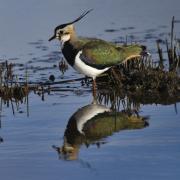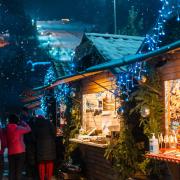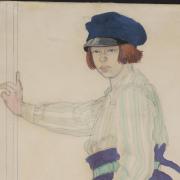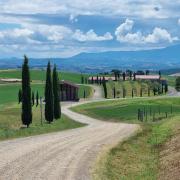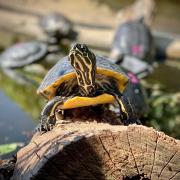A hide hidden in the Loder Valley Nature Reserve means patient nature enthusiasts can get a glimpse of badgers in their natural habitat.
From a cabin in the woods, I intensely scan a grassy slope in front of me, searching for movement. The longer the wait goes on, the more I start to see things. A wind-blown leaf transforms into a wagging tail, a stick poking out of the ground mutates into a snuffling snout.
Ten minutes pass… 20 minutes, then 30. I wait . Nothing. I supress every urge to move, to make any sound. Holding binoculars to my eyes, my right hand prickles with pins and needles. I dearly want to cough away a tickly throat. Instead of giving in, I concentrate my thoughts on the forest ahead.
I have joined a badger-watching evening at Loder Valley Nature Reserve, a weekly programme run by Wakehurst, Kew’s botanic garden in Ardingly, West Sussex. I am frozen, too frightened to move, or to barely breathe. But I have no intention of being the person who, just as the first badger of the night appears, trumpets a poorly timed sneeze or shifts position, scaring the creature off.
Our adventure began at a layby opposite The Gardeners Arms pub in which our group of amateur nature enthusiasts gathered, swapping stories of previous badger sightings.
There are 11 of us, mostly from Sussex and the majority have never seen a badger alive before. One lady had taken part in a similar experience with the Girl Guides , decades previously.
‘We fed them dog chocolates ,’ she tells me, explaining how the treats had lured the animals out of their sett. ‘I see they prefer to use peanuts these days.’ Much healthier, we agree.

My life’s collection of badger encounters has so far included the fictional (The Wind in the Willows, The Animals of Farthing Wood, Bodger & Badger) and the fallen, sadly mostly victims of one-sided car collisions. My lack of real-life encounters, therefore, put a lot of anticipation, and a little pressure, on the evening.
Leading us is reserve warden Steven Robinson, 56, who has been working in the Loder Valley for nearly 30 years. He grew up in the villages of Ardingly and Turners Hill and as a young boy ‘was out in the woods and countryside getting up to mischief but, at the same time, learning about how natural history works.’
Following a brief introduction , we set off on a 10-minute ramble . Leaving the B2028 behind and entering the Loder Valley Nature Reserve, we move in a snaking line, the more confident walkers up front, the less so taking careful steps.
This 150-acre space is a haven for wildlife with an abundance of ecosystems, including wetlands, meadows and woodlands which shelters all manner of critters: dormice, kingfishers and osprey among them. There are four badger setts here, Steven tells us, with around four to six residents in each.
We cut through a woodland in full bloom, passing wild garlic and bluebells, and arrive at our badger hide, a wooden hut at the foot of a hill. We enter and take a seat on a long wooden bench, which allows us to look through a glass window onto a grassy slope with the ground practically at eye level.
Steven scatters badger-friendly peanuts – the type found in bird feeders − some just inches from our window.
We sit and wait. Ten minutes, 20 minutes . Nothing, bar cheeky robins and blue tits darting from the branches to collect the nuts. After 30 minutes, I start to worry we may never see a badger.

My throat turns desert dry and my willpower wanes. I let out a pathetic muted cough, glancing sideways to see if anyone seems irritated. Then, just as I curse my weak willpower, my neighbour taps me excitedly in the midriff, pointing up and to the left.
I see nothing, but he jabs me once more, pointing again. Then, I see it. A pointy nose and a thick-set, shaggy black-and-white body , waddling through the undergrowth. My first badger. Even though the sighting is obscured, it is a thrilling moment. I see it rubbing against the vegetation, before it starts to snuffle the air. A perfume of peanuts, perhaps?
It seems so. The badger cautiously heads towards our hide, sniffing the air at regular intervals. Halfway to our location, however, it gets spooked and, with surprising speed and agility, dashes back into its sett.
That was, I’m told by Steven later, a sow named Halfear. The moniker is quite literal, with half her left ear missing.
‘Badgers are quite aggressive towards each other,’ Steven later explains, they’re highly territorial creatures. ‘They tend to fight nose to bum and they quite often tear each other’s ears off and take chunks out of their back.’
Now, however, we are back to waiting, eager for another sighting.
Ten minutes later, the same badger reappears. This time emboldened. Following her nose, she heads straight to the peanuts, chomping the food no more than 10ft from us. Then, she gets even closer, following the peanut trail until it is so close to my face that I can hear its jaws slapping together as she eats. Thankfully, she can’t see us, badgers have poor eyesight and the dark hide, plus the window between us which acts like a mirror, means we’re well hidden.

We enjoy 15 glorious minutes ‘with’ the animal, before it is joined by a second, larger, male. They feast together for 30 minutes, barely taking notice of one another as they enjoy dinner, dusk turning to night. All too soon, it is over, the badgers shuffling back into the forest and out of sight, no longer visible in the darkness. It’s a magical end to our own evening, a wildlife show played out before us. Now fully in darkness, they leave and , 90 minutes after arriving, so do we.
Back home, I call Steven to talk about our experience.
‘To see a whole badger virtually walk across your lap is definitely a very good success,’ he tells me. ‘Sometimes I underestimate what it must be like for people to see them that first time.’
I ask why I have seen so few in my life.
‘They are predominantly nocturnal and tend to stick to specific trails,’ he explains, adding, ‘their senses are so alert, they will probably detect you well before you get near them.’
Therefore, unless you have an intimate knowledge of the landscape and a tracker’s instinct, an expert like Steven is your best bet for a glimpse of these elusive creatures.
Still, I want to know more about how I can help badgers to flourish, so I speak to Pat Hayden, trustee and secretary of Badger Trust – Sussex, the local badger group for mid-Sussex. She tells me badger numbers in her patch are unknown, accurate surveys are currently impossible with the animals crossing county borders regularly, while also often moving in and out of their setts undetected. The population appears to be stable, though.
The key threats in Sussex, where the much-publicised badger cull, introduced in an effort to manage the spread of bovine tuberculosis , has not taken place, are development, badger baiting and poisoning. Of course, there are car collisions, too.
‘People drive too fast, ignoring speed limits and badgers crossing warning signs,’ says Pat. ‘In many cases, having hit a badger, drivers do not stop to see if it is alive and could be taken to a wildlife hospital for veterinary treatment.
‘In the early part of the year, when sows are giving birth, this is even more important as a dead or injured lactating sow may mean that new-born cubs are in jeopardy. Badger Trust – Sussex would like to search for the cubs as soon as possible. Sometimes they are lucky, more often, not. Badgers do not understand traffic – they follow tracks their forebears have followed for centuries and in many cases they turn to face oncoming traffic.’
In general, though, she tells me to keep vigilant. ‘There are many people throughout Sussex who love badgers and enjoy watching and feeding them in their gardens,’ she says.
‘Whenever people are out walking they may well be aware of local setts. It would always be helpful to have a quick look at them and to report anything which does not appear right. We would rather receive numerous calls where nothing turns out to be wrong than not to be told and are easily contactable on our 24-hour hotline.’
Now, I keep an eye out. So far, nothing, but I’d endure pins and needles in both arms and legs and fight off a hacking cough for another magical encounter. Until that time, I’ll have to make do with another episode of The Animals of Farthing Wood.
For more nature tours and events at Wakehurst, visit www.kew.org/wakehurst/whats-on. To report any suspicious badger activity, call the Badger Trust – Sussex hotline on 07910 198720.






